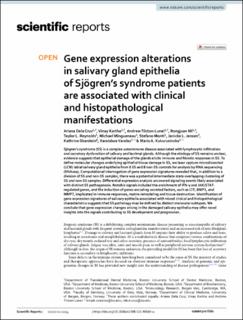| dc.contributor.author | Dela Cruz, Ariana | |
| dc.contributor.author | Kartha, Vinay | |
| dc.contributor.author | Tilston-Lunel, Andrew | |
| dc.contributor.author | Mi, Rongjuan | |
| dc.contributor.author | Reynolds, Taylor L. | |
| dc.contributor.author | Mingueneau, Michael | |
| dc.contributor.author | Monti, Stefano | |
| dc.contributor.author | Jensen, Janicke Liaaen | |
| dc.contributor.author | Skarstein, Kathrine | |
| dc.contributor.author | Varelas, Xaralabos | |
| dc.contributor.author | Kukuruzinska, Maria A. | |
| dc.date.accessioned | 2021-09-09T06:19:05Z | |
| dc.date.available | 2021-09-09T06:19:05Z | |
| dc.date.created | 2021-06-18T12:54:38Z | |
| dc.date.issued | 2021 | |
| dc.identifier.issn | 2045-2322 | |
| dc.identifier.uri | https://hdl.handle.net/11250/2774782 | |
| dc.description.abstract | Sjögren’s syndrome (SS) is a complex autoimmune disease associated with lymphocytic infiltration and secretory dysfunction of salivary and lacrimal glands. Although the etiology of SS remains unclear, evidence suggests that epithelial damage of the glands elicits immune and fibrotic responses in SS. To define molecular changes underlying epithelial tissue damage in SS, we laser capture microdissected (LCM) labial salivary gland epithelia from 8 SS and 8 non-SS controls for analysis by RNA sequencing (RNAseq). Computational interrogation of gene expression signatures revealed that, in addition to a division of SS and non-SS samples, there was a potential intermediate state overlapping clustering of SS and non-SS samples. Differential expression analysis uncovered signaling events likely associated with distinct SS pathogenesis. Notable signals included the enrichment of IFN-γ and JAK/STAT-regulated genes, and the induction of genes encoding secreted factors, such as LTF, BMP3, and MMP7, implicated in immune responses, matrix remodeling and tissue destruction. Identification of gene expression signatures of salivary epithelia associated with mixed clinical and histopathological characteristics suggests that SS pathology may be defined by distinct molecular subtypes. We conclude that gene expression changes arising in the damaged salivary epithelia may offer novel insights into the signals contributing to SS development and progression. | en_US |
| dc.language.iso | eng | en_US |
| dc.publisher | Nature Research | en_US |
| dc.rights | Navngivelse 4.0 Internasjonal | * |
| dc.rights.uri | http://creativecommons.org/licenses/by/4.0/deed.no | * |
| dc.title | Gene expression alterations in salivary gland epithelia of Sjögren’s syndrome patients are associated with clinical and histopathological manifestations | en_US |
| dc.type | Journal article | en_US |
| dc.type | Peer reviewed | en_US |
| dc.description.version | publishedVersion | en_US |
| dc.rights.holder | Copyright The Author(s) 2021 | en_US |
| dc.source.articlenumber | 11154 | en_US |
| cristin.ispublished | true | |
| cristin.fulltext | original | |
| cristin.qualitycode | 1 | |
| dc.identifier.doi | 10.1038/s41598-021-90569-w | |
| dc.identifier.cristin | 1916744 | |
| dc.source.journal | Scientific Reports | en_US |
| dc.identifier.citation | Scientific Reports. 2021, 11, 11154. | en_US |
| dc.source.volume | 11 | en_US |

